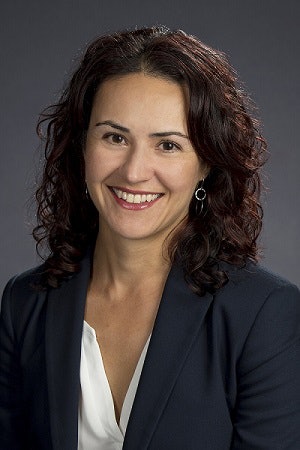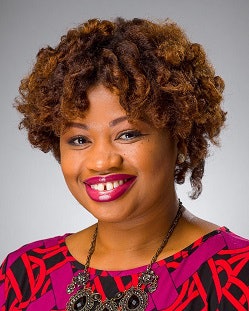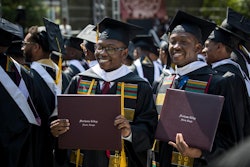Considering unease on many campuses regarding the Trump administration’s higher education policies — and proposals about college accessibility and affordability by presidential candidates who would like to win the White House next year — some academicians say the 2020 elections present significant opportunities to address urgent issues facing postsecondary learning.
 Dr. Liliana Garces
Dr. Liliana GarcesThe U.S. Department of Education, with secretary Betsy DeVos at the helm, has championed career and technical education, continued support of funding for historically Black colleges and universities and promoted unconventional ways of addressing the challenges facing higher education.
At the same time, the administration has implemented or recommended various controversial policies and positions, among them support for legal challenges to affirmative action; opposition to continuing the Deferred Action for Childhood Arrivals (DACA) program; warning schools that not enforcing freedom of speech rights could result in loss of federal research dollars; proposed revisions to Title IX guidance; what appears to many to be a softness toward for-profit institutions, a sector under fire for fraudulent practices and poor student outcomes; and recently repealing Gainful Employment regulations.
“What concerns me is what seems to have been a concerted effort to undermine efforts on the parts of institutions to try to expand access for historically marginalized populations,” said Dr. Liliana Garces, an associate professor in the Department of Educational Leadership and Policy in the University of Texas at Austin’s College of Education.
The administration has sought to discourage the constitutionally permitted use of race as a factor in admissions decisions, noted Garces, the Sid W. Richardson Regents Chair in Community College Leadership who also holds appointments as an affiliate faculty in UT Austin’s law school.
In several highly publicized cases, the Trump administration has sided with plaintiffs who are challenging race-consideration policies at colleges and universities, such as a suit pending against Harvard University on behalf of Asian American students who contend that affirmative action policies there unfairly discriminated against them.
The U.S. Supreme Court has affirmed allowance of the use of race as one of various factors that a college may consider when admitting students, most recently in 2015 in Fisher v. University of Texas at Austin. As a result, the Obama administration issued guidance for schools to use in crafting policies that promoted diversity and inclusion in their student populations.
That changed last year, when the Trump administration expressed favor for race-neutral admissions policies that follow the high court’s ruling but that themselves don’t discriminate
“They are rolling back federal guidance issued during the Obama administration that provided some helpful, practical guidance for institutions to understand how to read the decision and how it might play out on their campuses,” said Garces. “Although the Supreme Court decisions remain in place, that takes away an important practical tool that schools had to guide their practices.”
Another consequence of the philosophical and policy shift has been the administration redirecting resources in the Department of Justice to investigate claims of discrimination that target affirmative action plans intended to promote diversity and equity, observed Garces.
“In some ways, that intimidates institutions that want to use affirmative action plans in permitted ways,” she said.
Another source of criticism is the administration’s efforts to end the DACA program created by an Obama executive order after Congress failed to pass legislation addressing the legal status of millions of affected students.
“The situation exacerbated an already difficult position for a large segment of students who have lived here for most of their lives and were issued some protection under DACA,” said Garces. “With so much uncertainty around the future, it’s difficult to stay on campus. Some studies are showing the toll being in limbo is taking on students’ well-being, and it has made it more difficult for institutions to support those students. When you combine that with other immigration policies, the climate of fear and concern is very damaging.”
In evaluating the Trump administration’s record on higher education, Quinnipiac University’s Dr. Khalilah Brown-Dean graded the results a “D” – and that’s on a curve, said the associate professor of political science.
 Dr. Khalila L. Brown-Dean
Dr. Khalila L. Brown-Dean“The policies that have been enacted don’t address the heart of higher education,” she said. “Things like freedom of speech are more about political ideology than the heart of education.”
Dr. Ravi K. Perry, the former associate professor and chair of political science at Virginia Commonwealth University who will begin teaching at Howard University in the Fall, said he would stamp the administration’s progress report with “an F-minus.”
“When you appoint Betsy DeVos as secretary of education, you can’t be too concerned about education, particularly urban education,” he said. “We know the president doesn’t care much about college because the Republican Party doesn’t care much about college. The state of our education under the current administration is the worst it has been in modern American history.”
Perry cited steep cuts in the administration’s latest higher education budget proposal, a historical anti-education philosophy within the GOP and support for potentially risky concepts such as income-share agreements as alternatives to borrowing.
The administration’s impact on higher education “will be felt for a long time, in part because significant equity work done over the last 20 years has been undermined and rolled back,” said Dr. Sara Goldrick-Rab, professor of sociology and policy, organizational and leadership studies at Temple University.
“I’m especially concerned about the moves to make the for-profit sector great again,” she added. “They are helping for-profit colleges dodge regulation, refuting efforts to help defrauded borrowers, and so forth. The impacts are especially devastating for students of color, who are struggling with debt and are the deliberate targets of a sector that spends far more on advertising than on education.”
The academics said they like some of what they’re hearing from Democratic candidates for president, with proposals about free college and loan forgiveness prominent among policies put forth by the two dozen candidates who had joined the field by June.
“The exciting part is candidates see opportunities because the current administration has been more reactive than proactive when it comes to higher education,” said Dr. Mitchell J. Chang, professor of higher education and organizational change at the University of California, Los Angeles.
Many candidates have expressed support for increasing Pell grant amounts, cutting federal student loan interest rates, improving the Public Service Loan Forgiveness Program, incentivizing states to spend more on postsecondary education, raising funding levels for MSIs and some level of free college.
Among other higher education policies proposed by candidates:
• New York senator Kirsten Gillibrand has proposed two years of free public college in exchange for one year of public service and four years of free public college if a student gives two years of public service.
• Student loan forgiveness has the support of Indiana mayor Pete Buttigieg, who wants to expand debt-forgiveness programs for teachers and public servants.
• Former Texas Congressman Beto O’Rourke has expressed opposition to free college for all and recommends refinancing existing student loan debt at lower interest.
• In terms of funding HBCUs and other MSIs, California senator Kamala Harris recommends new funding for high-quality programs at those schools to address underrepresentation of teachers of color, an idea also supported by former vice president Joe Biden.
• Biden also proposes reinstating Obama-era guidance on affirmative action in higher education and allowing Pell grants to be used for dual enrollment programs that allow high school students to take classes at community college and earn college credits or a credential while in high school.
 Dr. Ravi K. Perry
Dr. Ravi K. PerrySenators Bernie Sanders and Elizabeth Warren have laid out the most extensive plans.
Sanders proposes tuition-free public college for students with family incomes under $125,000 and has introduced the College For All Act, which would make all public schools tuition-free.
To pay for that, the legislation would place two-thirds of the cost burden on the federal government and one-third on states and impose so-called Wall Street taxes ranging from .5 percent to .005 percent on investment houses, stock trades, hedge funds, bonds and derivatives.
Additionally, the bill would eliminate the requirement that students re-apply for financial aid every year, ask colleges to offer work-study programs to every interested student, hire more faculty and have a minimum of 75 percent of teaching done by tenured or tenure-track professors within five years of program implementation.
Warren’s policy proposals, meanwhile, deliberately promote equity and closing racial wealth gaps, such as $50 billion in aid to HBCUs.
Her student loan forgiveness plan would address racial disparities in debt burden by cancelling a maximum of $50,000 in debt for students with household incomes under $100,000 and loan forgiveness for borrowers in households with incomes of $100,000 to $250,000.
She projects that the policy would benefit 95 percent of borrowers, provide complete loan forgiveness for three in four, and result in full cancellation for 83 percent of Latinx students, 80 percent of Black students and 73 percent of White students.
Other provisions in Warren’s proposal would pump an additional $100 billion into the Pell grant program to pay the complete cost of attending a public school and establish a federal-states partnership that would eliminate tuition at four-year and two-year schools. “I find Elizabeth Warren’s proposals especially promising,” says Goldrick-Rab, “because they marry an effort to repair damage from loans with an effort to prevent future damage by making public higher education free.”
Brown-Dean lauded the wide range of proposals, adding, “We have to address finances as a barrier for young people, particularly first-generation and young people of color.”
“I think it is possible,” Brown-Dean said, “for a new president and Congress to create new public service fellowships or programs that would reduce debt obligation and provide incentives for young people to serve this country.” Garces likes much of what she’s hearing from candidates.
“It’s always a good idea to be introducing and discussing more progressive policy that can increase access and affordability,” she said. “It’s important to think about the affordability issue, and to understand that that plays out differently by race.”
Chang said he thinks tuition-free and loan-forgiveness initiatives should be more targeted, and he expects all candidates to ultimately “have something very significant to say about higher education as part of their campaign.”
 Dr. Mitchell J. Chang
Dr. Mitchell J. Chang“It has to do with the growing gap in wealth, and that is something I think all candidates will need to address,” he said. “There’s still a firm belief in this nation that higher education can be an important mechanism for closing that gap.”
“I think this is a good thing that we’re talking about addressing the bigger problem here, which is the wealth gap, and seeing higher education as one way to close that gap,” added Chang. “And this necessarily requires giving more access to more people to improve their chances of finishing. And when they’re finished, they aren’t into debt so deep that it prevents them from making the most of their education.”
What else should candidates be talking about to improve higher education? How to increase equity without diminishing access or quality, said Goldrick-Rab.
And “how to effectively address students’ living expenses,” she added. “I believe this will be done via supplemental programs, not by bigger investments in grant aid.”
Perry said it would be helpful for presidential hopefuls to lead “discussions as a country about what is the point of a college education. You’ve got to think very broadly about what college is and what colleges are supposed to do. An educated citizenry is more engaged with the democracy.”
Brown-Dean sees two critical areas that merit focus.
“First, candidates are not talking about what needs to happen at the primary and secondary level to prepare students to make good choices about college and career,” she said. “So, they can’t lament for-profit schools that waste kids’ money and give unaccredited degrees without looking at high school counselors seeing the potential in these kids and investing in them.”
Second, “particularly for students of color,” she said, “there’s been no discussion about the mental health crisis happening on campuses across the country. And defunding of those resources and services by the Trump administration has an impact on everybody. My concern is that in discussions, higher education is created as the bogeyman that’s charging people a lot of money with no return on their investment. But education helped build the Black middle class. I want candidates to address that reality.”
Chang said candidates should outline broader, more systems-oriented plans, particularly in light of unpredictable state funding.
“What I am not hearing is a systems analysis in thinking about higher education in the long-term,” he said. “What is needed is a clear systems approach to policies and how private institutions can participate.”
Funding and other policies must address a climate that generally helps private and elite institutions thrive while harming public colleges and universities, Chang said.
“Part of the solution is the role of serving the public good,” he said. “If they don’t take on the full share of this work as a system, the privates and the publics are going to be differentiated in a way with respect to stature that is going to increase the currency of a private degree and decrease the currency of a public degree. You may be creating a more stratified system, and stratification across higher education matters.”
Political polarization will make the road from campaign promise to official policy difficult, scholars predicted.
“It’s hard to stay optimistic that conversation will be around policy, we are so divided in the country right now,” said Garces.
Perry agreed, saying Democrats and Republicans “are moons apart. They’re nowhere near talking the same thing, so it’s hard to imagine any form of compromise.”
Strong disagreements on philosophy, policy and funding make it difficult for him to picture the parties coming together on solutions. He sees the best chances for progress with a Democrat in the Oval Office and a super-majority of Democrats in the House and Senate.
Meanwhile, it’s up to candidates to go beyond sloganeering and articulate specific policies, Perry said.
“There’s a difference between presidential vision statements about what our education should offer and what policies are with specific proposals. Not just politically pragmatic, but visionary and hopeful. Otherwise, it just leads to voter disillusionment and decreased participation in the process. If you believe in American exceptionalism, you would think that would mean vigorous investment in higher education. There’s no other solution but to pay for it.”
This article appeared in the July 11, 35th anniversary issue of Diverse.
LaMont Jones can be reached at [email protected]. You can follow him on Twitter @DrLaMontJones


















